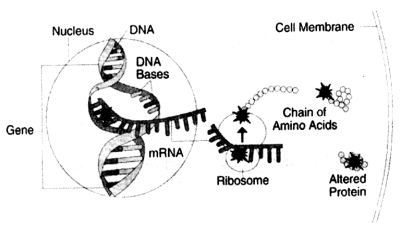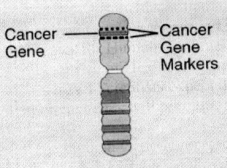 Fig. 50: Linkage of gene to disease. |
|
 Fig. 52: Maps of DNA can have several levels of detail; from the banding patterns of the chromosomes, to clones of overlapping segments of DNA, and ultimately to the base-by-base sequence of DNA. |
Many, if not most, diseases have their roots in our genes. Genes - through the proteins they encode - determine how efficiently we process foods, how effectively we detoxify poisons, and how vigorously we respond to infections. More than 4000 diseases are thought to stem from mutated genes inherited from one's mother and/or father. Common disorders such as heart disease and most cancers arise from a complex interplay among multiple genes and between genes and factors in the environment. When a gene contains a mutation, the protein encoded by that gene will be abnormal. Some protein changes are insignificant, others are disabling.[48]
Tracking down every chemical base in each of the estimated 50,000 to 1,00,000 genes as well as the spaces between them - mapping the human genome - is the task of an international 15 years collaboration known as the Human Genome project. (The united states efforts shared by the national cancer centre for Human Genome research at the National institutes of health and the office of health and environmental research of the Department of Energy). Scientists expect that having a detailed map of the entire set of human genes will revolutionize medical practice and biomedical research.
To construct a physical map, a chromosome (or in some cases, the whole genome) is first broken in smaller piece of DNA. Scientists then copy or clone the pieces in the laboratory, obtaining millions of identical copies of specific DNA segments. The next line up the clones to reflect the order that existed on the original chromosome. Information about the location and known genetic content of these unique and ordered DNA fragments (called contigs) is stored in a computer, while clone of the ordered pieces themselves are stored in laboratory freezers. When genetic linkage maps indicate that a gene lies in a particular region, scientists can go to the freezer and retrieve clones of interest, they then use the clones as the raw material for DNA sequencing - actually identifying the order of each and every chemical base in the gene.
Benefiting from the increasingly detailed maps and sophisticated DNA sequencing techniques and tools, scientists are mapping and isolating new disease genes at the rate of several per month. By the year 2005, scientists have pinpointed the location of each of the 50,000 to 1,00,000 genes and identified the exact sequences of their chemical bases.[49]
 Prof. Dr. Sohan Raj Tater
Prof. Dr. Sohan Raj Tater

 Doctoral Thesis, JVBU
Doctoral Thesis, JVBU